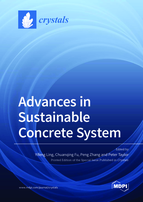Advances in Sustainable Concrete System
A special issue of Crystals (ISSN 2073-4352). This special issue belongs to the section "Hybrid and Composite Crystalline Materials".
Deadline for manuscript submissions: closed (31 December 2021) | Viewed by 63082
Special Issue Editors
Interests: cementitious materials; industrial wastes; concrete pavement; concrete durability; geopolymer
Special Issues, Collections and Topics in MDPI journals
Interests: reinforced concrete; durability; corrosion
Interests: geopolymer composites; fiber-reinforced concrete; nanoparticle reinforced concrete; green concrete composites
Special Issues, Collections and Topics in MDPI journals
Special Issue Information
Dear Colleagues,
Concrete is the most widely used construction material in the world and is typically produced using Portland cement (PC) as the binder. The mass of PC used in concrete construction brings a critical environmental issue due to the high emission of carbon dioxide gas during its manufacture from the calcination of limestone and the combustion of fossil fuel. On the other hand, the rising demands to reduce the cost of binder in concrete desiderate aim to offer an alternative source of PC. To date, new concrete systems, such as geopolymer concrete, magnesium phosphate concrete, and concrete using supplementary cementitious materials have been extensively explored in concrete research.
This Special Issue aims to publish current advanced concrete studies on environmentally friendly or cost-effective concretes or wastes recycling. The qualified papers focus on, but are not limited to, the properties, evaluation, novel manufacturing/experimental techniques, analytical methods, microstructure, modeling, design, production, and practical applications of new binders/aggregates in concrete, and their behaviors in the concrete structures of in situ performance, renovation, maintenance, recycling, durability, and sustainability.
Dr. Yifeng Ling
Prof. Dr. Chuanqing Fu
Dr. Peng Zhang
Dr. Peter Taylor
Guest Editors
Manuscript Submission Information
Manuscripts should be submitted online at www.mdpi.com by registering and logging in to this website. Once you are registered, click here to go to the submission form. Manuscripts can be submitted until the deadline. All submissions that pass pre-check are peer-reviewed. Accepted papers will be published continuously in the journal (as soon as accepted) and will be listed together on the special issue website. Research articles, review articles as well as short communications are invited. For planned papers, a title and short abstract (about 100 words) can be sent to the Editorial Office for announcement on this website.
Submitted manuscripts should not have been published previously, nor be under consideration for publication elsewhere (except conference proceedings papers). All manuscripts are thoroughly refereed through a single-blind peer-review process. A guide for authors and other relevant information for submission of manuscripts is available on the Instructions for Authors page. Crystals is an international peer-reviewed open access monthly journal published by MDPI.
Please visit the Instructions for Authors page before submitting a manuscript. The Article Processing Charge (APC) for publication in this open access journal is 2600 CHF (Swiss Francs). Submitted papers should be well formatted and use good English. Authors may use MDPI's English editing service prior to publication or during author revisions.
Keywords
- Concrete binder
- Concrete structure
- Geopolymer
- Supplementary cementitious materials
- Manufacturing/experimental techniques
- Waste recycling
- Sustainability
- Self-healing concrete
- Eco-efficient concrete
- Microstructure
- Durability








